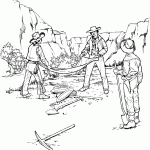Here’s the three big questions and answers about finding gold

Now lets get on to those big questions and my answers…
Here’s a list of the three biggest questions I’ve been asked about finding gold. Take a good look at the questions and my answers. See if you agree these are your biggest questions as well, let me know what you think…
Q 1: Where do you start finding gold?
The easy way to start finding gold is to begin by looking where gold has been discovered before. This means get your hands on a gold map showing the locations and quality of gold that was discovered. From here it is a straightforward interpolation between the origin of the gold and its current likely location.
To use these gold maps, you’ll need to understand the relationships between gold, gravity, topology and water flow. By connecting these four physical properties together using some pretty simple science you can quickly determine where to start looking for and finding gold.
Q 2: What important clues do you look for to find gold?
This next process is a fun one, by understanding what you’re looking for in the way of hydrology, topology, geology clues you’ll begin to put together a picture from a given gold site. This picture is literally a map of where gold concentrates and where it is likely to concentrate. You’ll have a list of the best specific locations that you should start your sampling efforts for more effective gold recovery.
In general, in a stream or river situation gold will follow an S-curve with the gold line crossing over the banks on the inside of any bends. This happens because of a water flow property called helical flow. It’s important to understand this flow, and also important to understand exceptions to this kind of flow so you know where the gold will be and more importantly where it will not be.
Q 3: What tools should you use to discover gold?
You should always carry a gold pan, start small and scale up the size of the equipment to use based on the gold that you’re finding. Seems like a pretty simple concept, but if you watch Discovery channels “Gold rush” it’s pretty easy to see how often it’s overlooked. Especially when you begin to find colors in your pan.
Gold fever can blind you to all sorts of rational thinking regarding the purchase and use of equipment. Before you know it you’re out a bunch of cash and not enough gold to show for it.
A few other tools of choice that you should consider are: a rock pick, a shovel, a bucket: 5 gallon orange “Homer” buckets are okay but not necessarily as durable as I like. I prefer a thick plastic white paint bucket, they last longer in the sun.
And of course don’t forget that your most important tool is your brain. The knowledge and skill (experienced intuition about gold finding) is vital for success in locating and recovering significant quantities of gold regardless of if you’re doing it for fun or for profit.
Want to boost your skills and knowledge of how to find gold fast?
I’ve created a set of five DVDs called the “Gold Prospectors Collection” that is intended to address just this type of gold finding issue:
This set of 5 DVDs includes the most popular gold prospecting videos I have, and so far the comments have honestly been both exciting and humbling because I have had so much positive feedback. I believe you will be just as excited as the people who took this offer and bought “The Gold Prospector’s DVD Collection.”
Anyway, you get all 5 gold prospecting DVD’s shipped right to the door, and you can watch them on your TV, computer, or any device that can play DVDs, at home or in the field. Watch this video for more…
Check it out now, just click here to learn more – https://sourdoughminer.com/collection.html
Thanks for giving me a minute of your time to read this article, and as always, good prospecting!
Best Regards,
Prospector Jess
Hi Jess, I am a vermon prospector and I have been checking an outcrop of very dark reddish iron like material in a narrow quartz vein which is running through a slate like host rock. I havent found any sign of significant au in it YET, but I was wondering what your take would be. I could send pics if you would like to see them.
Thanks